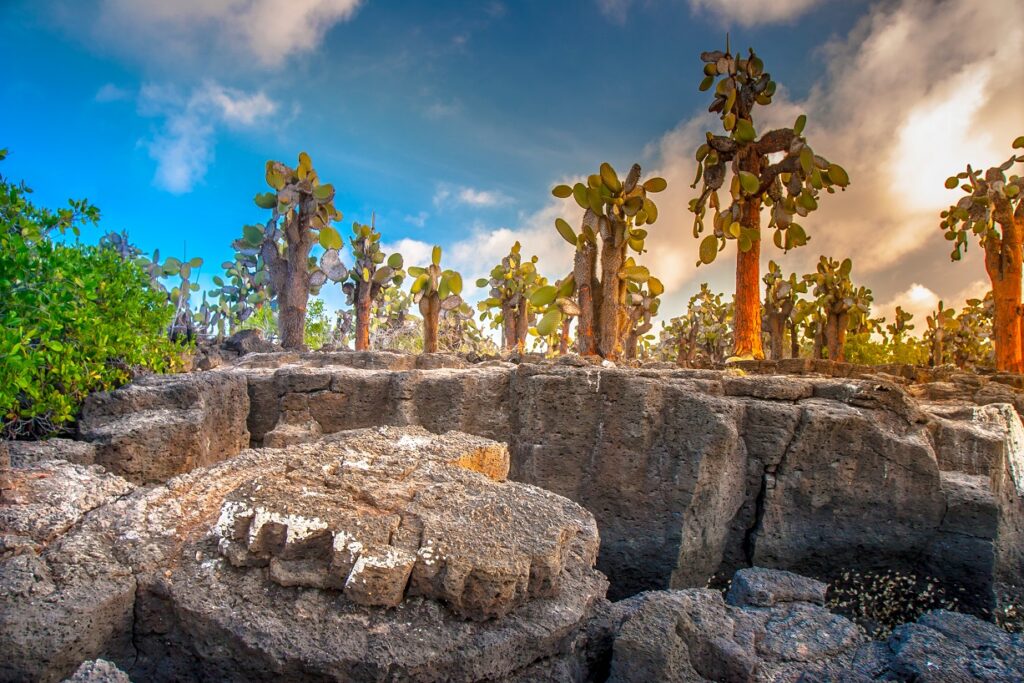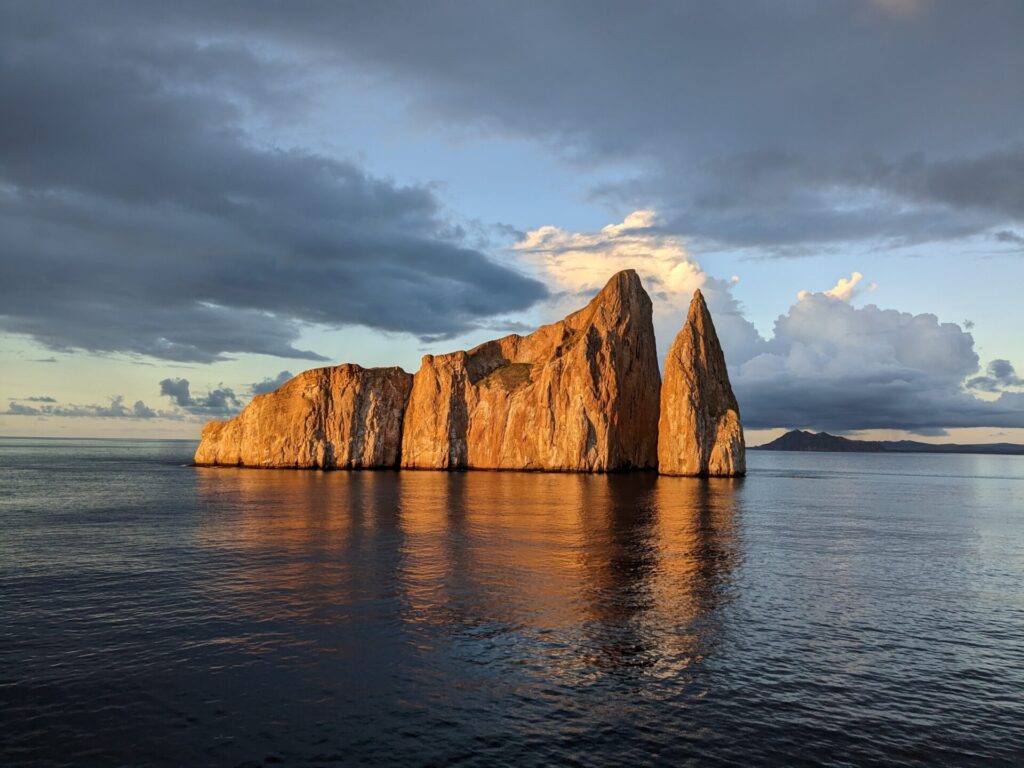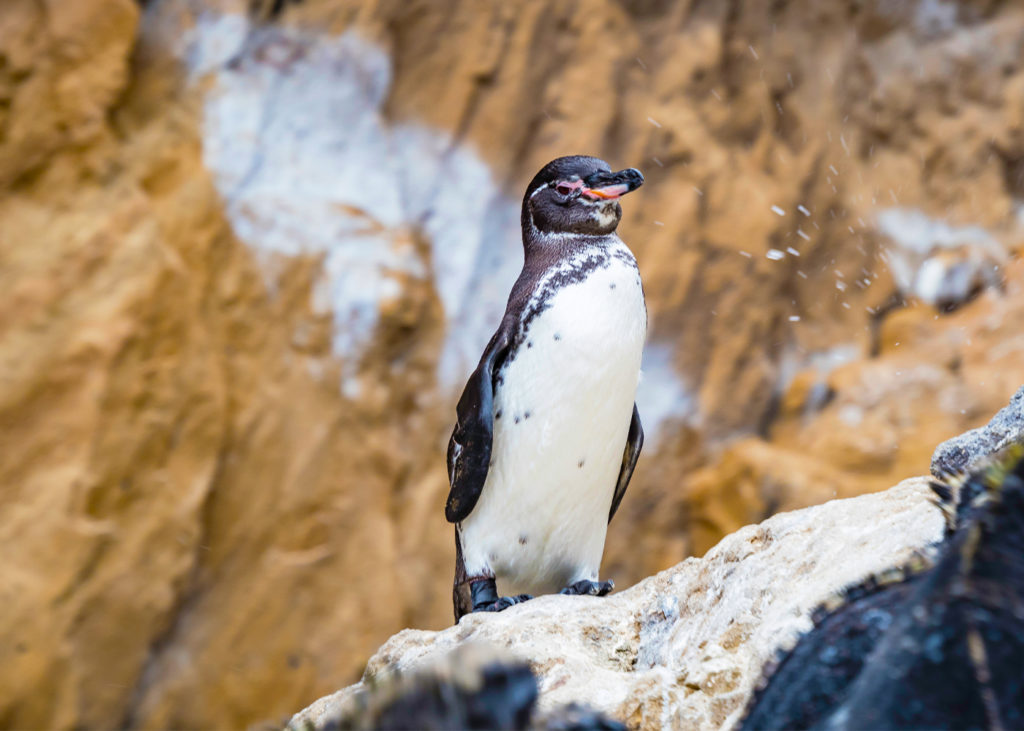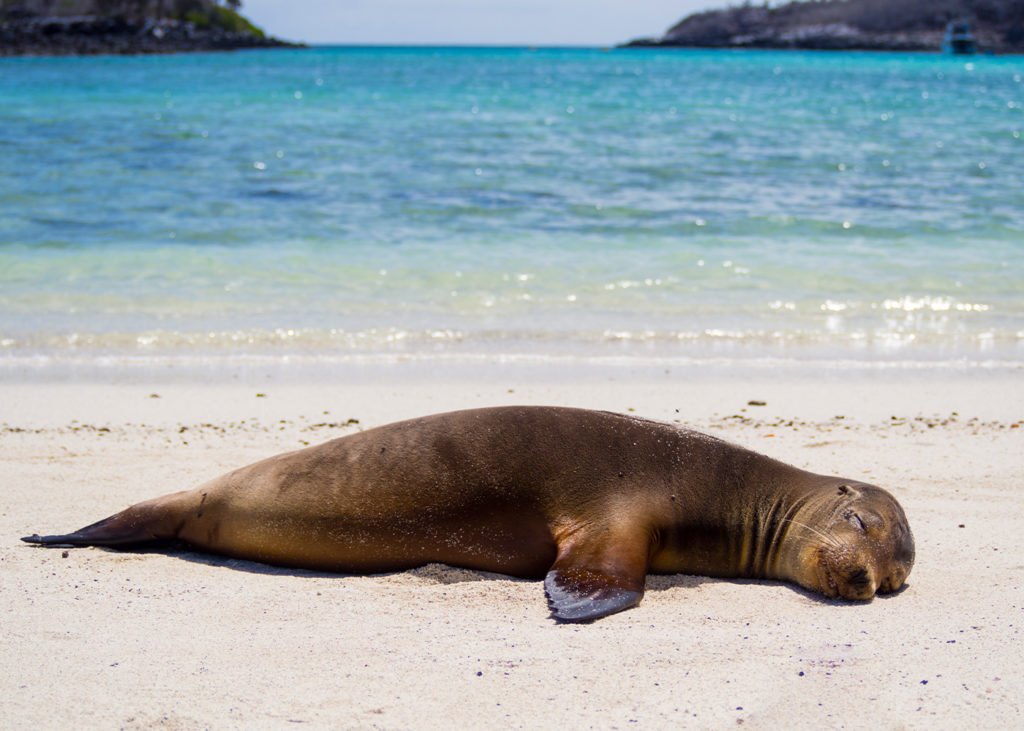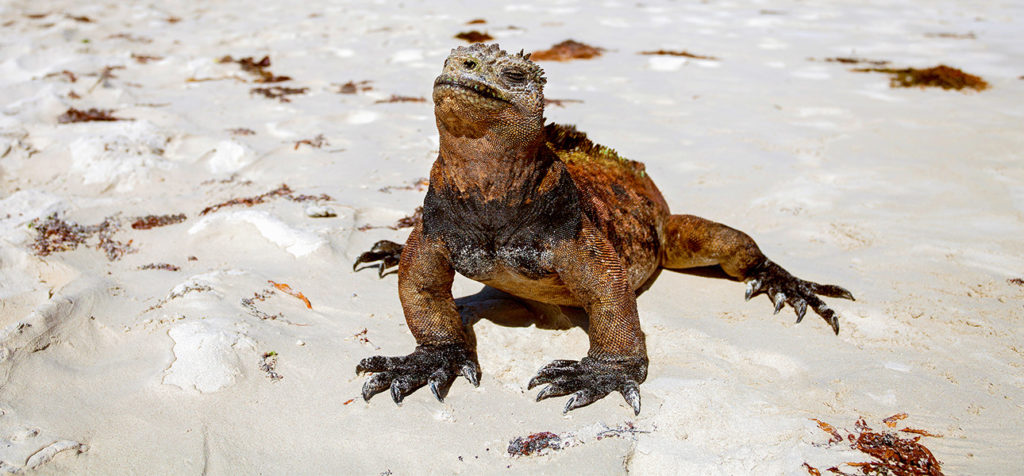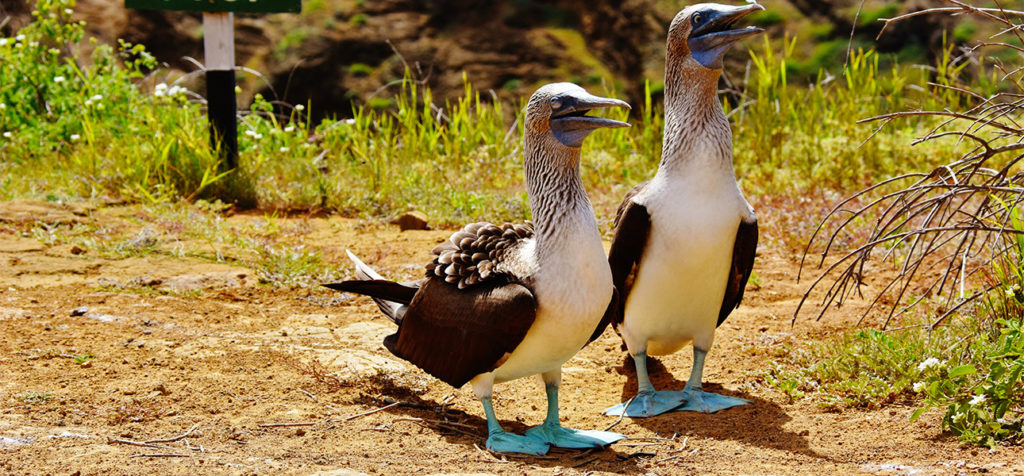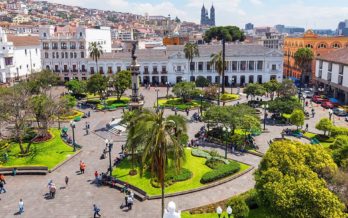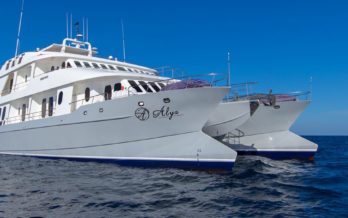Cruise Overview
The M/Y Coral I and II are fully equipped and spacious motor yachts designed with teakwood and modern decorum to give a unique Galapagos tour an exclusive touch. Each cabin has its own full private bathroom and is handsomely decorated with deep wooden fixtures, the interior of the yacht is fully carpeted.
The dining room and lounge demonstrate a refined taste and the yachts have three sun decks, one half-shaded. Equipped with all the standards you would expect from a high-class yacht, the M/Y Corals are modern ships in a timeless realm.
Cabin Types
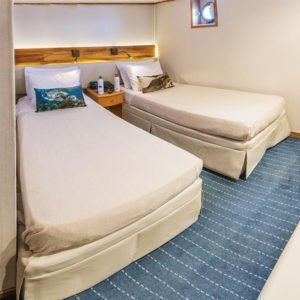
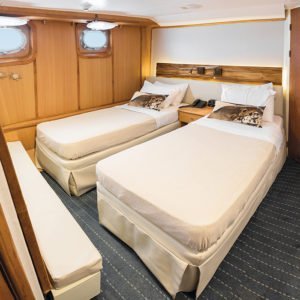
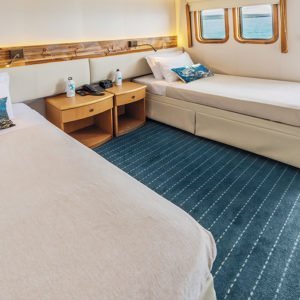
Route Map
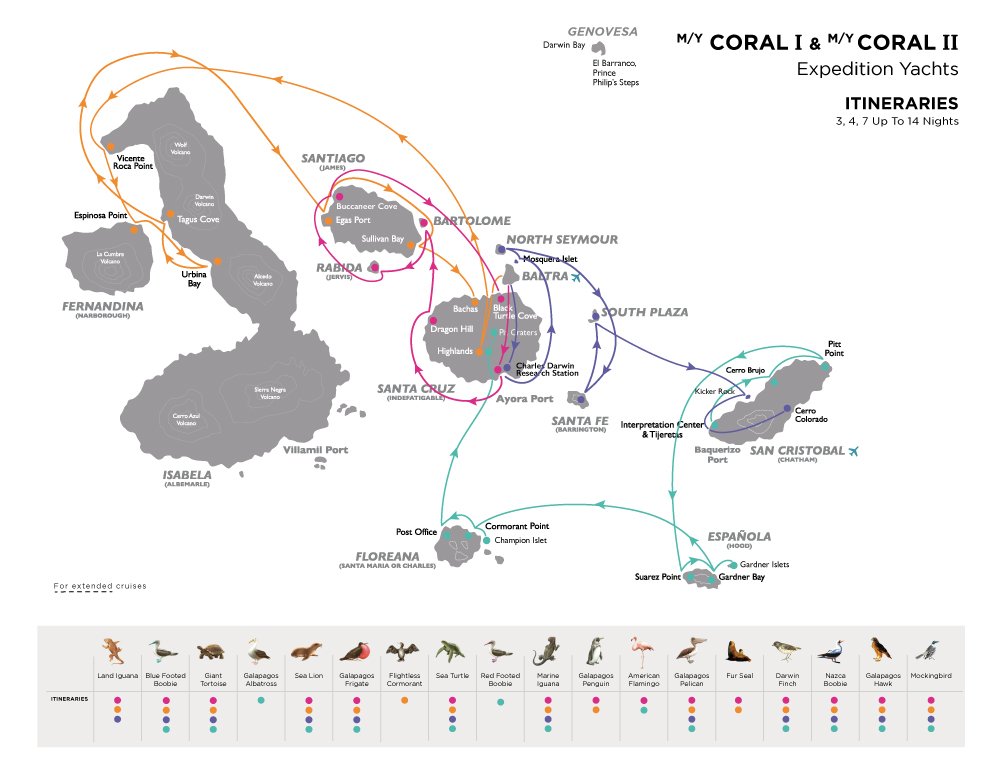
Itinerary A - North Central Islands
Departs Sundays
Departure from Quito or Guayaquil to Baltra (2 ½ hours flight). Arriving in Galapagos, passengers are picked up at the airport by our naturalist guides and taken on a ten minute bus drive to the pier to board the M/Y Coral I or M/Y Coral II.
Afternoon Excursion: Fausto Llerena Breeding Center – Charles Darwin Station (Santa Cruz Island)
Dry landing. We visit the Station where the Galapagos giant tortoise breeding program takes place as part of our efforts to preserve the fragile Galapagos environment and where the famous Lonesome George (the last surviving specimen of his species) lived for decades. The program is conducted by GNP staff with the collaboration of scientists from the CDRS. Eggs are brought from the Galapagos Islands of Pinzon, Santiago and Santa Cruz to the station. The eggs are incubated artificially; the “galapaguitos” (little Galapagos) are born and reared until the age of 5 years; they are released in their native areas when they are capable of surviving the effects of introduced predators (rats, pigs and dogs). Since 1970, more than 2000 “galapaguitos” have returned to the native areas. Moreover, admire a prickly-pear cactus forest and variety Darwin Finches and other land birds. In addition, the Darwin Station works in providing environmental education to communities, schools within the Islands and tourists who are visiting the Galapagos Islands. If there is enough time, you can visit the town and shop for souvenirs.
Morning Excursion: Dragon Hill (Santa Cruz)
We walk by a brackish lagoon where feeding flamingos can be occasionally found. The trail leads across typical dry zone vegetation up to Dragon Hill, an important nesting ground for endemic land iguanas, offering lovely views of the anchorage and neighbouring islands. The forest is home to mockingbirds, Darwin’s finches, Yellow Warblers, and Galápagos Doves.
Afternoon Excursion: Bartolomé
We discover a fascinating moonscape formed by different volcanic parasitic cones —lava bombs, spatter, cinder cones —as we hike to the summit for impressive views of the surrounding islands, including the eroded tuff cone Pinnacle Rock. We also encounter marine iguanas, lava lizards, and blue-footed boobies.
Beach time is a great opportunity to snorkel and see (perhaps swim with) Galápagos Penguins, sea turtles and White-tipped Reef Sharks among a great variety of colourful fish. For many visitors, this may turn out to be the best of snorkelling experiences; the water here is generally clear, without too much surf and full of marine life.
Due to its geographical location, the lack of vegetation is immediately noticeable.
Pioneer plants are observed, so called because they are the first to establish roots on new ground. They include Tiquilia nesiotica (which is endemic to the island) and Chamaesyce (known as sand mat or spurge in English), lava cactus, and Scalesia bushes. Behind the beach, we have dunes covered by mangroves.
Morning Excursion: Rabida
Dark-red sand covers these unique beaches with the incredible landscape; Rábida is considered the epicentre of the Galápagos Islands due to the diversity of its volcanic geology. Nesting Brown Pelicans are found from July through September and nine species of the famous Darwin’s finches can be seen. We will also take a dinghy ride along cliffs to observe nesting seabirds, and snorkel off the coast, where marine life is particularly active.
Afternoon Excursion: Bachas Beach (Santa Cruz)
Wet landing on the north side of Santa Cruz; behind the beach lie two small flamingo ponds with iguanas, coastal birds, Darwin finches, mockingbirds, and gulls, as well as interesting native and endemic vegetation, red and black mangroves, salt bushes, and much more. This beach is one of the main nesting sites of sea turtles in the Galápagos. A female can lay eggs 3 or 4 times with an average of 70 eggs each, but then spend 3 or 5 years without breeding.
At this paradisiacal site, we will also find the remains of barges that sank long ago, once the property of the United States Navy when they operated an airbase on Baltra Island during World War II. That is why the beach is called “Bachas” because the word “barges” in English was hard to pronounce for the local people.
Morning Excursion: Black Turtle Cove (Santa Cruz)
The north shore of Santa Cruz Island, accessible only by sea where four species of mangrove crowd from the shore out into the lagoon, turtle enjoy swimming in the calm waters, peaking their heads above the surface while fish, rays and small sharks circle below. White-tipped reef sharks can be seen beneath the boat, sea birds, including pelicans, herons and egrets, all feed in the cove. This cove has been declared as a “Turtle Sanctuary”.
After the visit, passengers will be transferred to Baltra airport for return flight to Guayaquil or Quito.
Itinerary B - West Islands
Departs Wednesdays
On arrival, you will be met by the naturalist guide who will guide you on your journey through the magnificent Galapagos Islands. A short bus ride takes you from the airport to where your boat and crew await you for your trip of a lifetime. From the dock you get a glimpse of what your trip will be like. Frigate birds soar high above the azure blue bay while blue-footed boobies dive like shooting arrows from the heights and submerge after fish below.
Afternoon Excursion: Eden Islet / Ballena Bay (Santa Cruz Island)
Off the western coast of Santa Cruz, Eden Islet offers opportunities to see Nazca and Blue-footed boobies, Reef sharks, and Endemic Salemas, either from the dinghy or during snorkelling. Wet landing in “Ballena” (Whale) Bay, this is a beautiful green sand cove at the base of Dragon Hill on the west coast of Santa Cruz Island. The beach contains a large amount of olivine crystals of volcanic origin. The crystals were formed when the magma was still underground. The content is magnesium, iron and silica. A small population of tortoises from Pinzón Island lived at the site, but were probably taken by whalers or previous inhabitants. Opportunity to see marine iguanas and sea birds, followed by snorkelling.
Morning Excursion: Vicente Roca Point (Isabela Island)
This point is a promontory with two protected turquoise coves on either side of the remains of a tuff cone, one of them accessible from the sea only through water-filled subterranean passages, so it is a marine-only visitor site with really great opportunities for deep-water snorkelling thanks to its location at one of the richest marine ecosystems on Earth (Bolivar Channel). In this part of the Galápagos, the upwelling of cold water currents from the West offer an abundant food supply for marine species that supports a wide variety of marine life: Red-lipped batfish, Sea horses, Frogfish, Nudibranchs and Octopi, the Mola mola or Sun fish has also been spotted close to the rock walls. It is common to observe groups of dolphins, Sea Lions and tunas feeding here. The geological formations here are very impressive a sheer cliff provides the perfect setting for a dinghy ride along the coast to observe a great diversity of sea and coastal birds: Noddies, Brown pelicans, Galápagos Penguins and Flightless Cormorants. Marine birds such as Pelicans or Nazca and Blue-footed boobies are often seen feeding all at once in these waters. There are whale-watching opportunities during the cold season (May – December) while navigating from Vicente Roca Point to Espinosa Point.
Afternoon Excursion: Espinosa Point (Fernandina Island)
Espinosa Point is the only spot that we visit on Fernandina, and from it we can see the island of Isabela across the Bolívar Channel, an area that boasts some of the highest diversity of endemic sea fauna in the Galápagos. The largest, most primitive-looking race of marine iguanas are found mingling with Sea Lions and Sally Lightfoot Crabs; a wonderful opportunity to encounter Flightless Cormorants at their nesting sites, Galápagos Penguins and the “King” of predators on the Islands, the Galápagos Hawk.
“Pa-hoe-hoe” and “AA” lava formations cover the majority of the terrain. Vegetation is thus scarce inland, but we encounter Brachycereus cacti and extensive mangrove beds lining the shores.
Morning Excursion: Urbina Bay (Isabela Island)
Depending on the season, we may find Giant tortoises, Land iguanas and the unusual Flightless Cormorant. After a short walk inland, snorkelling time is allotted, giving you yet another chance to swim with Sea turtles, Sea lions and countless tropical fish. Urbina Bay features a wide variety of plant life that changes depending on the season. We can observe the beautiful colours of plants that attract different insects, birds and reptiles. We will explore the uplifted coral reef that resulted from 1954 volcanic activity, with a spectacular view of Alcedo Volcano.
There are whale-watching opportunities during the cold season (May – December) while navigating from Urbina Bay to Tagus Cove.
Afternoon Excursion: Tagus Cove (Isabela Island)
The trail leads to Darwin salt-water Crater Lake and excellent views of lava fields and volcanic formations. This us a great site to see landbirds such as Galápagos Hawks, Ground and Tree finches, Large-billed flycatchers and Yellow warblers.
We will return by the same path for a dinghy ride along a shoreline full of marine wildlife, where we will admire a variety of Seabirds such as Blue-footed booby, Brown Noddy, Terns, Flightless Cormorant and, depending on the season, a large number of Galápagos Penguins which are only 35 cm tall; the only penguin species in the world to extend its range into the northern hemisphere along the Equator. They lay their eggs in small cracks of lava, on the lower parts of the island near the shoreline not reached by the ocean waves. Most of the individuals live on this Western portion of Isabela, others are scattered further South on the Island. We will have an opportunity to snorkel in deep water.
Graffiti believed to have been left by19th-century pirates is a curious reminder of an intriguing past. Many names of the early visitors to this site, pirates and whalers, are written on the cliffs along the shore.
Morning Excursion: Salt Mines / Egas Port (Santiago Island)
Wet landing a beach of black volcanic sand, visited by Darwin in 1835. Salt Mines visitor site has an important history, on 1683 William Ambrose Cowley visited this place, it was he who gave the English name of James to the Bay and the Island. British buccaneers anchored in this whole area during the 1600s since it was a good place to provide them with water, tortoises and salt from the salt-lake that lied down into the crater. The first part of Egas Port trail is comprised of volcanic ash (eroded tuff) and the other half of the trail is partially uneven terrain, comprised of volcanic basaltic rock that lounges the shoreline and take you to the best tidal pool areas in the Galápagos that are populated by Fur Seals and Sally Lightfoot crabs.
The unique, truly striking layered terrain of Santiago’s shores is home to a variety of resident and migrant birds including the bizarre Yellow-crowned Night Heron, the Galápagos hawk is often observed in this area as well. Snorkelling in this place is a highlight, astounding array of marine wildlife including Lobster, Starfish and Marine iguanas grazing on algae beds alongside Sally Lightfoot Crabs. Snorkelling also offers rarities such as Octopus or Squid. At this visitor site you can observe the two species of sea lions: Fur “seals” and Galápagos Sea Lion. Colonies of Endemic Fur Seals swimming in cool water pools formed by volcanic rocks can be seen.
Afternoon Excursion: Sullivan Bay (Santiago Island)
This visitor site located at the Southeastern portion of Santiago Island is of important geologic interest, features extensive Pahoehoe lava flows believed to have been formed during the last quarter of the 19th century. In the inland section of the trail, in the middle of the lava flow, appear older reddish-yellow-coloured tuff cones where Mollugo plants and their yellow-to-orange whorled leaves which usually grow out of the fissures. Walking on the lava is breathtaking, this flow is geologically very young, the magma formed is flat but the movement of underground lava, the rapid cooling, and other eruptions make it look like it just solidified.
Morning Excursion: “El Chato” Reserve (Santa Cruz Island)
We will reach the Santa Cruz highlands and visit a private farm and natural tortoise reserve “El Chato” / “Primicias”, where Giant Tortoises are found in their natural habitat, as well as land birds such as Tree and Ground Finches, Vermillion Flycatchers, Paint-billed Crakes, Yellow Warblers and Cattle Egrets. The journey to the reserve offers great opportunities to see the contrasts that the islands offer in regard of variety of ecosystems, life and geology, the road goes from the coast through the agricultural zone and straight up to the dense forests of the highlands that emerge from a light fog. Often, tortoises are also seen on the way, wandering through pastures in the agricultural zone. Land birds can also be observed along the excursion, this visit is actually of important interest for birdwatchers since they can observe here almost every land bird present in the islands.
After the excursion you will go straight to the airport for return flight to Guayaquil or Quito.
Itinerary C - East Islands
Departs Sundays
Departure from Quito or Guayaquil to Baltra (2 ½ hours flight). Passengers are picked up at the airport by our naturalist guides and taken on a ten minute bus drive to the pier to board the M/Y Coral I or M/Y Coral II.
Afternoon Excursion: Fausto Llerena Breeding Center – Charles Darwin Station (Santa Cruz Island)
We visit the Station where the Galapagos giant tortoise breeding program takes place as part of our efforts to preserve the fragile Galapagos environment and where the famous Lonesome George (the last surviving specimen of his species) lived for decades. The program is conducted by GNP staff with the collaboration of scientists from the CDRS. Eggs are brought from the Galapagos
Islands of Pinzon, Santiago and Santa Cruz to the station. The eggs are incubated artificially; the “galapaguitos” (little Galapagos) are born and reared until the age of 5 years; they are released in their native areas when they are capable of surviving the effects of introduced predators (rats, pigs and dogs). Since 1970, more than 2000 “galapaguitos” have returned to the native areas. Moreover, admire a prickly-pear cactus forest and variety Darwin Finches and other land birds. In addition, the
Darwin Station works in providing environmental education to communities, schools within the Islands and tourists who are visiting the Galapagos Islands. If there is enough time, you can visit the town and shop for souvenirs.
Morning Excursion: Mosquera Islet
Mosquera Islet is located between North Seymour and Baltra Island. This flat, sandy island has a large colony of Sea Lions. It is also an excellent site to observe shorebirds such as Herons and Lava Gulls. There is no trail on Mosquera Island, so any visitor can enjoy the open area. Most of the islet is covered with sand and barren lava rock. Very little Sesuviumportulacastrum grows on the sand.
Afternoon Excursion: North Seymour Island
Off the Baltra Island (where one of the airports is located) and not far from Santa Cruz, we find North Seymour. This island was formed by a series of underwater volcanic lava which was deposited in layers on the ocean floor. An approximately two hour walk amidst large nesting colonies of Blue-footed boobies, Magnificent and Great frigate birds, and Swallow-tailed gulls for an in depth encounter with sea bird breeding cycles. You will also encounter Sea Lions, Land Iguanas, and on a lucky day, you might even come across a Galápagos Snake.
Morning Excursion: Santa Fe Island
Wet landing on a white sand beach surrounded by a Sea Lion colony; we continue walking through an endemic cactus forest as we search for the endemic Santa Fe land iguana (the largest in the islands), and the distinctively paler. This island is home to a number of endemic species including Galápagos Hawk, Galápagos Snake, rice rats, a variety of finches and one of the four mockingbird species of the Galápagos.
Afternoon Excursion: South Plaza (Plaza Island)
There are two Plaza Islands located east of Santa Cruz Island, though visitors only land on the South Plaza. This is a dry landing on the Northern part of the Islet. The walk begins with an impressive cactus forest surrounded by the colourful yellow and red Land Iguanas and Marine Iguanas; as we reach its highest point, be on the lookout for Tropicbirds, it is also home to one of the largest Sea Lion colonies. In South Plaza, there is a large colony of the smaller sized Land Iguanas. The population is approximately 300 individuals. They feed on all kinds of vegetation, but during the dry season, they survive on fruits and flowers of the Opuntia cacti. We will encounter the one and only Galápagos Hybrid Iguana. Stumble upon a bright red landscape which is a characteristic of the Island during the dry season (June – January) when the succulent plant Sesuviumedmonstonei turns red (it is regularly greenish to yellowish). The Portulacaoleracea is also common in South Plaza; it is the favourite source of food of the land iguanas.
Morning Excursion: Interpretation Center & Tijeretas (San Cristobal Island)
Dry landing in Puerto Baquerizo Moreno, the capital of the Galápagos Islands. Passengers visit the Interpretation Centre, which is one of the components of the project “Plan of Interpretation and Environmental Education for the Galápagos Islands”, which is an excellent place to learn about natural history in the Islands. The Museum of Natural History displays information on the volcanic origins of the islands, their remoteness from the continent, ocean currents, climate, the arrival of the different species and their colonisation, among other points of interest. The human history is also showcased, chronologically narrating the most significant events related to the discovery and colonisation of the islands. A high-intensity hike might be taken to visit Tijeretas Hill to admire beautiful landscapes ending with a magnificent view of a nearby large Frigate bird colony. If there is enough time, we´ll go to the island´s town for some shopping.
After the visit, you will go straight to the airport for your returning flight to Guayaquil or Quito.
Itinerary D - South Islands
Departs Wednesdays
Departure from Quito or Guayaquil to San Cristobal (2 ½ hours flight). In Galapagos, passengers are picked up at the airport by our naturalist guides and taken on a ten minute bus drive to the pier to board the M/Y Coral I or M/Y Coral II.
Afternoon Excursion: Cerro Colorado Tortoise Reserve (San Cristobal Island)
Dry landing in Puerto Baquerizo Moreno. Visit the San Cristobal Tortoise Breeding and Rearing Centre for young tortoises; this place is called “Jacinto Gordillo” located in the vicinity of Cerro Colorado (where the name comes from). This is one of the few places where you can see Calandriniagalapagosa, a plant endemic to San Cristobal.
Passengers can learn about the National Park’s conservation programs and also about an assisted reproduction program that started after the birth of a little turtle in captivity. If there is enough time, passengers will have the opportunity to visit the port village, have a drink or shop for arts and crafts and other souvenirs.
Morning Excursion: Cerro Brujo (San Cristobal Island)
Cerro Brujo is an eroding tuff cone that is composed, in several locations, by lava formations, and a beautiful white sand beach which is great for snorkelling and sunbathing. We visit a lagoon where migratory bird species can be seen: Black-necked Stilts, Ruddy Turnstones, Whimbrels, other sandpiper species and White-cheeked Pintails. Cerro Brujo offers beautiful views of Kicker Rock, the southern part of San Cristobal and the adjacent coast.
Afternoon Excursion: Pitt Point & Pitt Islet (San Cristobal Island)
Wet landing followed by a high-intensity hike on rocky terrain. The trail goes through several magnificent viewpoints including: an olivine beach of 90 meters long and a path that climbs to the top of a volcanic tuff. This is probably the only site where the three booby species of the Galapagos can be seen together: Nazca, Blue-footed, and Red-footed; as well as the two species of Frigate birds and a Sea Lion colony; it is also excellent for dinghy rides and snorkeling, where a good range of sea birds can be observed.
Morning Excursion: Suarez Point (Espanola Island)
Dry landing. An island of geological interest being one of the oldest in Galapagos, it has a high percentage of endemism because it is also one of the most isolated in the archipelago. This, and the great variety of wildlife found makes this site one of the most attractive in the Galapagos.
We explore volcanic formations and a riveting wildlife: large colonies of Sea Lion and seabirds including Española mockingbird, Nazca boobies, and the spectacular Red Billed tropic bird. You will also encounter singular Marine iguanas that have a turquoise colour with red in the breeding season, Lava lizards, and the colourful Sally Light Foot crabs.
A somewhat lengthy hike will bring you among Nazca and Blue-footed boobies, right up to nesting grounds that sometimes overlap the trail. Other birding favourites include Galapagos Dove, Galapagos Hawk, Swallow-tailed gulls and the world’s largest colony of Waved Albatross, an unequivocal highlight during mating season (April- December).
Admire the island’s dramatic backdrop, featuring the famous “Soplador”, a seaward blowhole that shoots water at some 23 m. (75 ft.) in the air.
Afternoon Excursion: Gardner Bay (Espanola Island)
Wet landing in Gardner Bay, on a beautiful white coral sand beach guarded by a colony of Sea Lions. There are no trails, so we stay along the shore where we can spot Galapagos Hawk, American Oystercatcher, Galapagos Dove, Hood Mockingbird, Yellow Warbler, Lava lizards, Marine iguanas, and three species of Darwin Finches: a subspecies (Geospizafuliginosa) of the Large Cactus Finch, which is similar to the large ground finch, the Small Ground Finch (Geospizafuliginosa) and the
Warbler Finch (Certhideaolivacea) which is another endemic subspecies. Swimming and snorkeling offer a great variety of Galapagos marine wildlife: King Angelfish, Creole fish, Damsel fish and Parrot fish.
Morning Excursion: Champion Islet / Devil’s Crown / Cormorant Point (Floreana Island)
Champion is a small Islet located just offshore Floreana Island, offers great dinghy rides or snorkelling along a nice wall filled with a variety of marine wildlife like the endemic Black Striped Salema, the Blue Lobster, Long Nose Hawkfish, Sea Horses, Coral Hawkfish, Sea Lions, and the famous Red-lipped batfish. Devil’s Crown is considered one of the best sites for snorkelling; here you can watch Galapagos Penguins, Sea Lions, turtles, sharks, dolphins, and fish diversity. Wet landing on an olivine green sand beach. We hike from the black mangrove beds to a brackish lagoon, which usually holds one of the largest flamingo populations in the Galapagos.
This island features some endemic plants such as Scalesiavillosa, White and Black Mangrove, and Holy Stick. The trail continues to a beautiful white-sand beach, one of the most important nesting sites of Green Pacific Sea Turtles. From the beach one can spot Sea Turtles, Blue-footed Boobies plunging into the water, and small Reef Sharks floating and searching for food along the shoreline. This coral sand-beach marks the end of our trail, and we head back to the olivine beach we landed on to swim or snorkel amongst Sea Turtles, Reef fish, Sea Lions and, on a good day, White-tipped Reef sharks. A small colony of Galapagos Penguins resides on Floreana and can sometimes be observed as well.
Afternoon Excursion: Post Office (Floreana Island)
A wet landing on the north side of Floreana, leading to the bay of Post Office (named like this because, in 1793, Captain James Colnett installed a wooden barrel which served as an informal post office for sailors passing through, who would take letters with them to their destinations. Today, our visitors continue the tradition by placing unstamped postcards inside the barrel that should reach their destinations for free. It can take weeks, months, even years, not arrive at all, or even arrive before you! We may also encounter Darwin Finches, Yellow Warbler, and Lava Lizards. Great snorkelling opportunities with Green Pacific Sea Turtles and on the main beach among playful sea lions. Moreover, this island is best known for its endemic vegetation: Scalesiavillosa, Lecocarpuspinnatifidus, and Galapagos milkwort.
Morning Excursion: Highlands (Santa Cruz Island)
We will reach the Santa Cruz highlands and visit a private farm and natural tortoise reserve “El Chato” / “Primicias”, where Giant Tortoises are found in their natural habitat, as well as land birds such as Tree and Ground Finches, Vermillion Flycatchers, Paint-billed Crakes, Yellow Warblers and Cattle Egrets. The journey to the reserve offers great opportunities to see the contrasts that the island offers in reference to the variety of ecosystems, life, and geology. The road goes from the coast through the agricultural zone and straight up to the dense forests of the highlands that emerge from a light fog. Often, tortoises are also seen on the way, wandering through pastures in the agricultural zone. Land birds can also be observed along the excursion. This visit is of important interest for birdwatchers since they can observe almost every land bird present on the island.
After the excursion you will go straight to the airport to take your returning flight to Guayaquil or Quito.
Tour Inclusions
- All shore excursions with multilingual speaking guides.
- All meals scheduled on board.
- Coffee/tea 24-hour station.
- Snorkelling gear and kayaking equipment.
- Baggage handling and transfers and dinghy rides to and from ports.
- Shuttle service in Quito and Guayaquil to/from designated hotels to connect to flights.

